Frugal Laundry Tips & Strategies – A Comprehensive Look
This post may contain affiliate links. Read our disclosure policy here.
Looking for even more ways to save money and live a frugal life? I’m diving into some frugal laundry strategies to see what can shave the most dollars off of my bills each month.
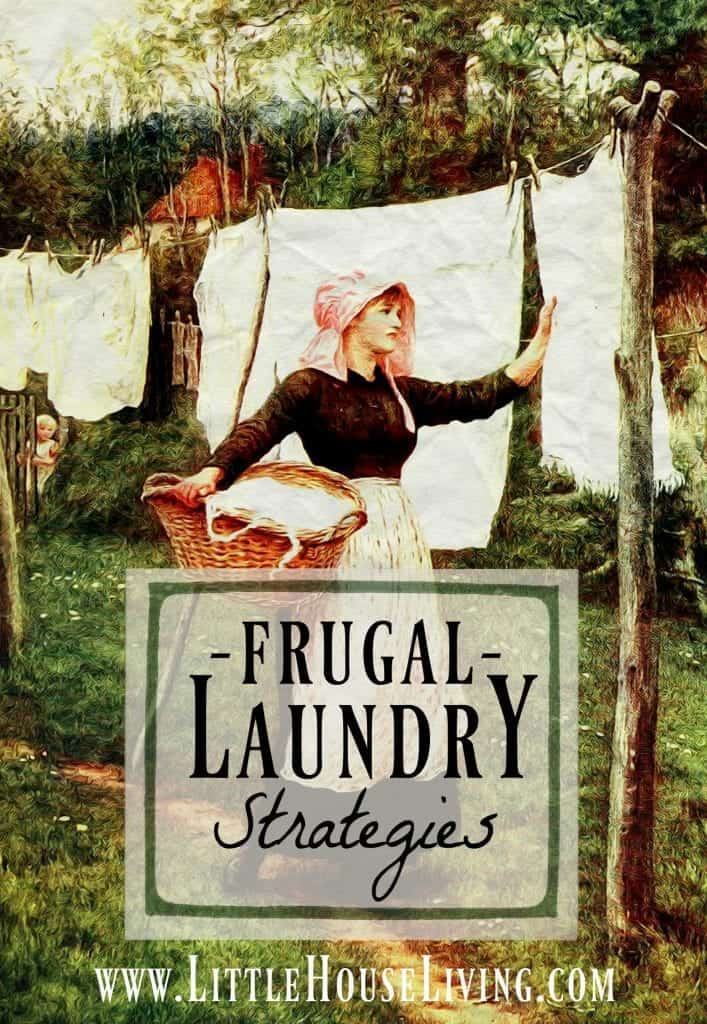
Frugal Laundry Strategies
One of our goals this year and over the course of the next few years is to become debt-free. After so many years of living frugally, we had been somewhat burned out, and the regular little strategies of saving money never really seemed to add up to much. But now, with our more firm goal in mind, we want to do whatever we need to to stretch our very limited budget and see how much we can really save without having to go to the extremes that are hard to continue in the long term.
With 3 children, we go through quite a bit of laundry. I can only imagine what those of you with 4, 5, 6, or more children have to deal with on a daily basis! Of course, ours are all in the mess-maker stages right now, which means there is no such thing as wearing an outfit for more than one day. The nice thing is that all of the clothes are small, so we can really pack a large load into our washer.
Tip: Too many kids clothes? Here are some tips on how to create a minimalistic kids closet.
I’ve been using all of the “regular” money-saving strategies for a long time, but recently, I’ve been trying out some new methods of cutting back to see how much we can save.
Despite not feeling like we use much energy, our electric bill still seems too high, and I’d love to cut it down as much as possible. You might already know some of these tips, but I hope that this article will at least encourage you to try some frugal strategies when it comes to washing and drying your laundry.
Frugal Washing Strategies
Never wash in warm water. Unless you have some really crazy stains or bacteria that truly only come off with warm water (in which case, pre-soaking still may be a better method), there is no need to wash in warm water.
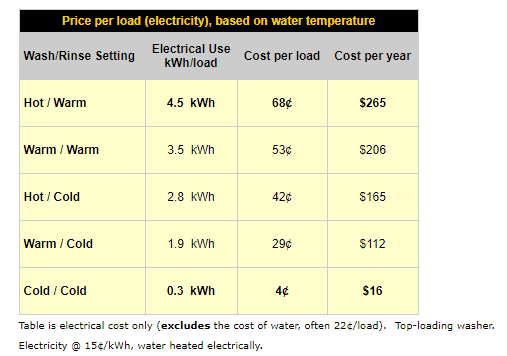
Hot water can damage clothing and can also cause shrinkage. For basic spots and stains (food, dirt, etc), I’ve never had trouble with getting clothing clean using cold water. And believe me, food stains are collected at my home on a daily basis…. x5. Mr. Electricity (see above) reports that washing a load of clothing in warm water costs about $0.68, while the same load in cold water costs about $0.04.
If you wash one load of clothing per day in cold water instead of warm water, at those rates in a year, you would save $214. That’s significant.
Tip: Want to save money while washing dishes? Here are my tips for that!
Full load or small load? If our clothes aren’t too dirty (just from daily wear) I will usually always make sure to do a full load of laundry. Not overloaded, though, since they won’t get clean.
However, if my clothes are really dirty from work or gardening, we will run a small load. So I don’t think it’s ok to say that you should always run a full load of laundry to save money. It will depend on the soil level of the clothing. Running a full load does no good if the clothes are still dirty and have to be washed again.
I keep the whites, stained clothing items etc in separate stacked baskets. Once the basket is enough for the washer, it has a turn to either soak or gets washed.
Any washing I do, get shaken out well before hanging and placed on hanger where possible, that cuts down on ironing substantially. As I use a clothing rack there is no need for pegs – a time saver!
Each person in the family has a pack away basket, as clothing is dry it gets folded into their individual baskets,which cuts down a bit of time on the after sorting.Teenagers in general have a lot of washing so I let mine pack their own away – makes them aware of the amount of
Angie, Little House Living reader
clothing they use.
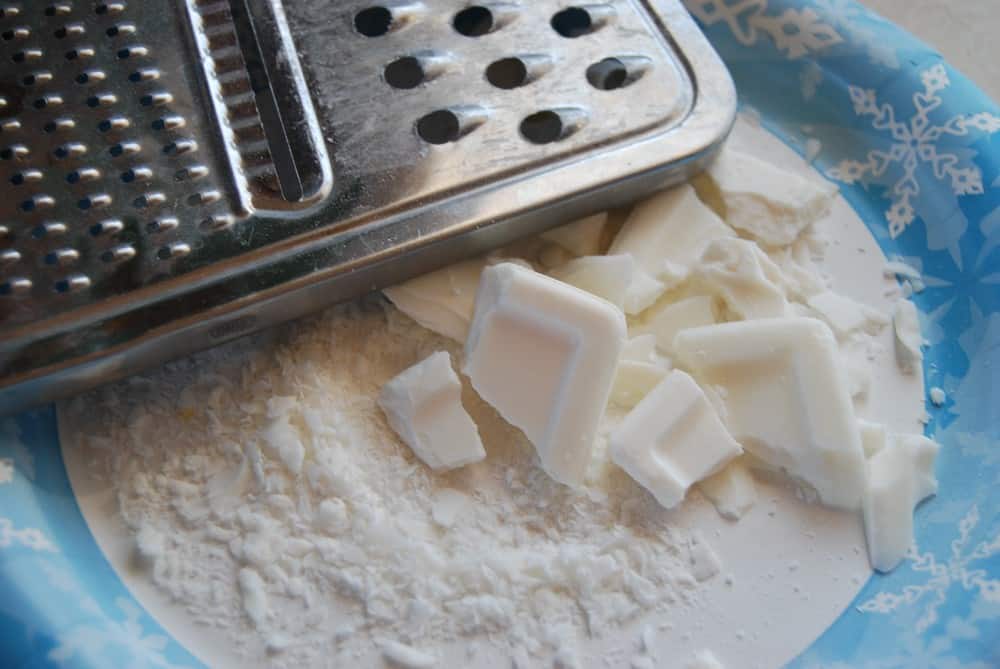
Consider how much soap you really need. If you are making your own laundry detergent, you already have lowered the price of washing soap. However, have you really stopped to think about if you actually need the amount of soap that you are using? If you are using a regular detergent from the store, Tide, for example, your cost per load of laundry is around $0.21 (just for the detergent).
Homemade Laundry Detergent usually costs between $0.05 and $0.10 per load, so you already have significant savings if you use that versus buying it in the bottle from the store. I’m quite partial to the Homemade Laundry Detergent recipe in my book, Little House Living (no borax!), although you can find another recipe for Homemade Laundry Detergent here.
Recently, I decided to try a little experiment. I have a little scoop that I use to put in my laundry detergent, and I always fill it half full and add that amount to a load. What would happen if I only filled the scoop 1/3 of the way full? I’ll tell you…nothing changed. My clothes were still the same amount of clean and didn’t smell any dingier than when I filled the scoop to the normal amount.
For the sake of easy math, we will estimate that my detergent costs $0.10 per load, and by using less, I’m reducing that to $0.06 per load. If I washed daily and used the lesser amount, I would save $14.60 per year. If I switched from store-bought detergent to my homemade amount and used the lesser amount, the savings would be $54.75 per year. Not astronomical savings, but a very easy way to save a bit of money.
I only wash laundry once a week, lol. Seriously. Sunday is my washing day. Unless someone had an accident or needs something quickly, I’m only doing laundry one day a week. It’s my husband, myself & 2 boys.
Melissa, Little House Living reader
One of which who has asthma. I’ve wanted to hang my clothes outside to dry for years, but his Doctor told me to not do that. Hopefully once he’s older, I can start.
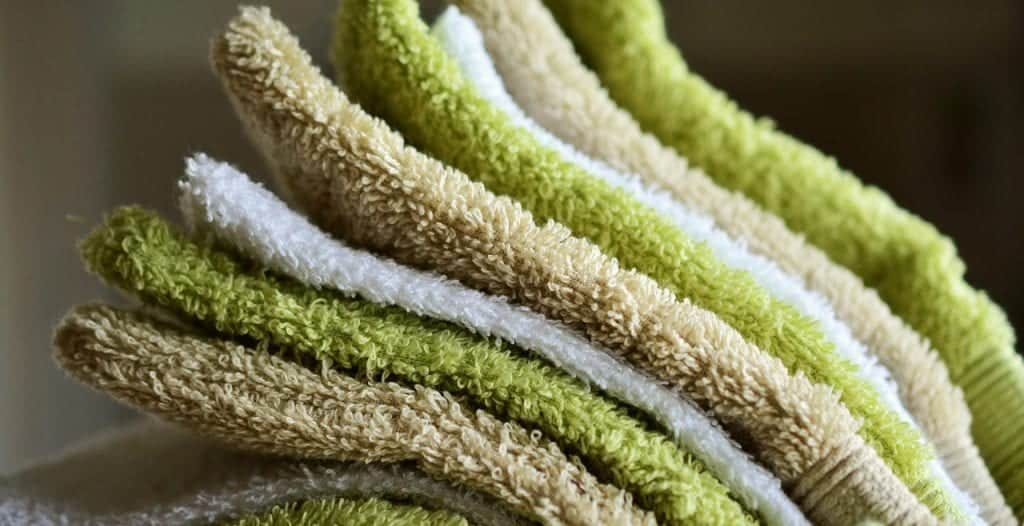
How much cleaner will a full-length wash get your clothes? Another experiment I began doing was testing out the “quick wash” feature on my washer. A regular cycle on my high-efficiency front-loading washer took 1 hour and 15 minutes, whereas my average quick wash cycle was 20 minutes.
A regular wash with a high-efficiency washer costs $0.22 per load, including electricity and detergent (if you figure washing in only cold water and using a homemade detergent at its regular price). Keep in mind that a top-loading washer will cost more (about $0.36 per load).
With my digging around, I could not find out how much water a quick wash uses, so for the sake of easy math, we will just say that it costs 50% less to run the quick wash overall. That would make one load of clothes, washed in a HE washer with cold water and homemade detergent, about $0.16 or about $0.23 per load for a top-loading washer. Figuring one wash per day, this could save you between $21.90 and $47.95 per year.
Again, it’s not a huge savings but still something to look into. My favorite part of this tip is that a quick wash saves so much time doing laundry! I like to get up early, and if I start laundry when I get up, I can be almost completely done by the time the kids get up. No more waiting for laundry to finish washing so I can get about my day.
How many loads/week does vary a lot by family. We are probably closer to 4 loads/week, but I have friends that do much more. I have been trying not to wash clothes until they are visibly dirty or smell, not after every wear. Clothing lasts SO much longer when washed in cold & line dried like Merissa suggests and not washing as often!
Sheena, Little House Living reader

Frugal Drying Strategies
You can hang dry no matter where you live. I must have heard it hundreds of times over the lifetime of this blog, “I can’t hang laundry outside because….” Guess what? I can’t always hang laundry outside either (allergies), but I can still hang my laundry to dry.
Running one load of laundry in the dryer (electric) costs at least $0.44 to $0.66+ per load, depending on your electricity cost and if you are using a gas or electric dryer. Using the “Air Dry” cycle might save you a little bit of wear on your clothing, but overall, it doesn’t save much more money than running a regular dry cycle. The best way to save on drying your laundry is by hanging.
Tip: Here’s a cute little DIY Clothespin Bag!
You may not want to hang dry all of your clothes, and that’s ok. I usually do not hang socks and some undergarments or some towels. They tend to get crunchy and have a weird texture. If you wash every day and dry only half of your clothing in the dryer, it will save you $80.30 – $120.45 per year. That’s a great savings!
If you are unable to hang your clothes outside like I am, some great alternatives can be:
- Using a drying rack. Amazon has a large selection. I have a metal drying rack since the wooden ones tend to mildew after a while if you live in a humid area.
- String a laundry line in a warm room in your home. I utilize this method in the summer.
- Hang up clothing on hangers in doorways of unused areas. There are plenty of places to hang clothes if you just look!
I’ve seen some articles and websites that claim that hanging your clothes isn’t worth the time and even go so far as to figure out your “minimum wage” for hanging laundry, saying that it takes, on average, 25 minutes to hang a load. Personally, I’ve never had a load take me more than 5-10 minutes to hang up, and I think it’s well worth my time to save the money as well as extend the life of my clothing.
I hang dry almost everything. In the summer I have a line outside and if it’s sunny and a bit breezy I can get 3-4 loads out there a day. I usually do my laundry on the weekend. In the winter I have two drying racks that I put in front of the baseboard heaters, one in the bedroom and one in the living room. Lighter things get hung up on hangers and put in the closet or the shower curtain. The only thing I dry in the dryer in the winter is hubby’s heavy work hoodies…they take about 3 days to dry on the rack and by then they smell funky, and the towels. I even drape my sheets on the racks, folded into thirds and then after a few hours they get flipped over. I haven’t made my own laundry soap yet, but a year ago I made some home made soap and put too much oatmeal in it, so I’m thinking of grating it up and using it for laundry. Thanks so much Merissa…..Love your blog and all your suggestions for living a more sustainable life.
Kate, Little House Living reader
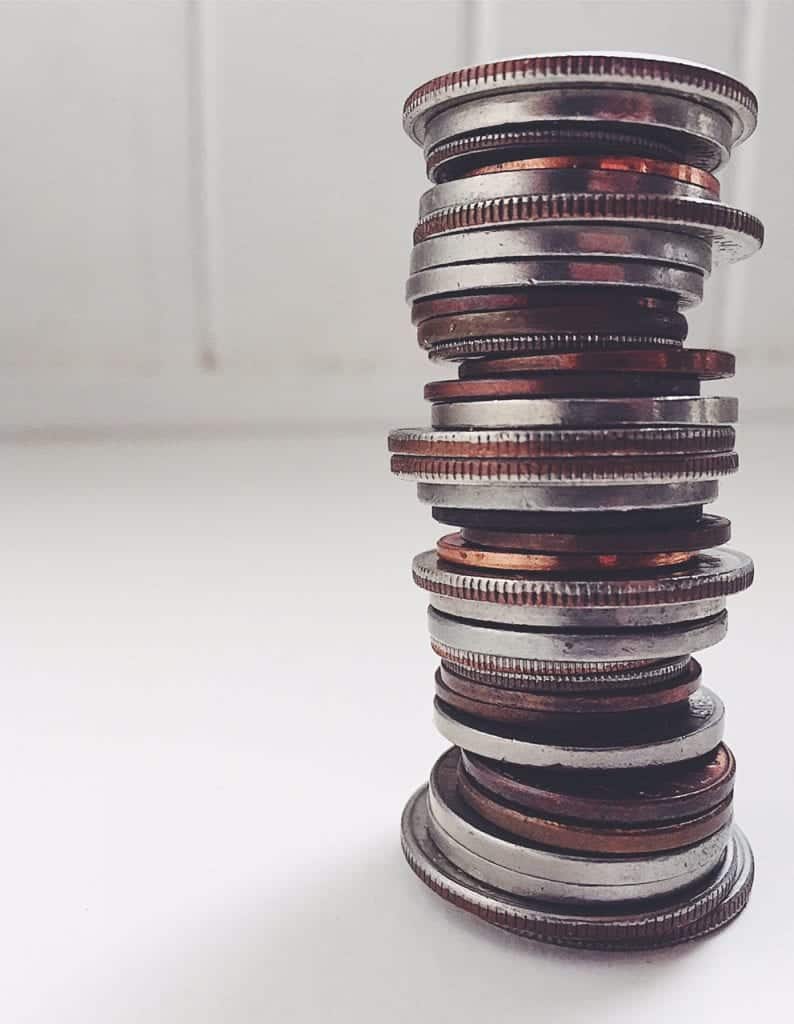
Quick Frugal Laundry Tips
Here are some additional tips to consider along with the strategies above:
- Always clean out the lint trap in the dryer. Do this on the dryer before every load and on the outside vent a few times a year.
- Never wash a partial load. If you have one or two items that need to be cleaned immediately, hand wash, or soak them until you can run them with a regular load.
- Always use a moisture-sensing dry cycle if your machine is equipped. Timed dry can over-dry your clothing.
- Wear clothing twice if possible. Use towels many times before washing.
- An iron is the cheapest way to remove wrinkles from clothing. Don’t use the dryer as an alternative.
- Make whatever laundry products that you can at home. I have wonderfully effective recipes for both fabric softener and a stain stick in my book, Little House Living. They only cost pennies to make!
- Use a magnet ball in the washer. Softens the water and you only require 1/2-1/4 the soap per load! – Lehla B.
- Use wool dryer balls, and dry on low heat what you don’t hang. – Kyla S.
- Try using Soap Nuts. – Jennifer H.
- Wash/dry during non-peak electric hours. – Sarah C.
- Use washing soda for all kinds of things with your laundry.
If I have heavy items that don’t dry fast, I add a fan to the rack to speed it up. As long as the appliance doesn’t have to generate heat, it is still lower cost than the dryer. I also have ditched the flannel sheets for the bed. They take up too much water and take forever to dry, both on the rack and in the dryer. I have found these polyester sheets that are 1200 thread count for $25 a set. With the new synthetics, they are warm as toast and actually breathe. I have also made my pajamas out of light weight fleece. Both the pajamas and sheets dry in no time and are wearing much more efficiently that the cottons I previously used. And with the fleece I can turn the thermostat down at night. It was a big leap to embrace synthetics but the argument to buy something to last longer and be less of an impact on the environment won. Synthetic fibers can be made from reclaimed products and the processing of natural fibers is not without it’s own impact. The amount of water needed to produce linen is shocking. I wish more people would embrace savings for savings sake and not do it only when their backs are against the wall. It’s not about being poor, it’s about having consciousness and awareness.
Theresa, Little House Living reader
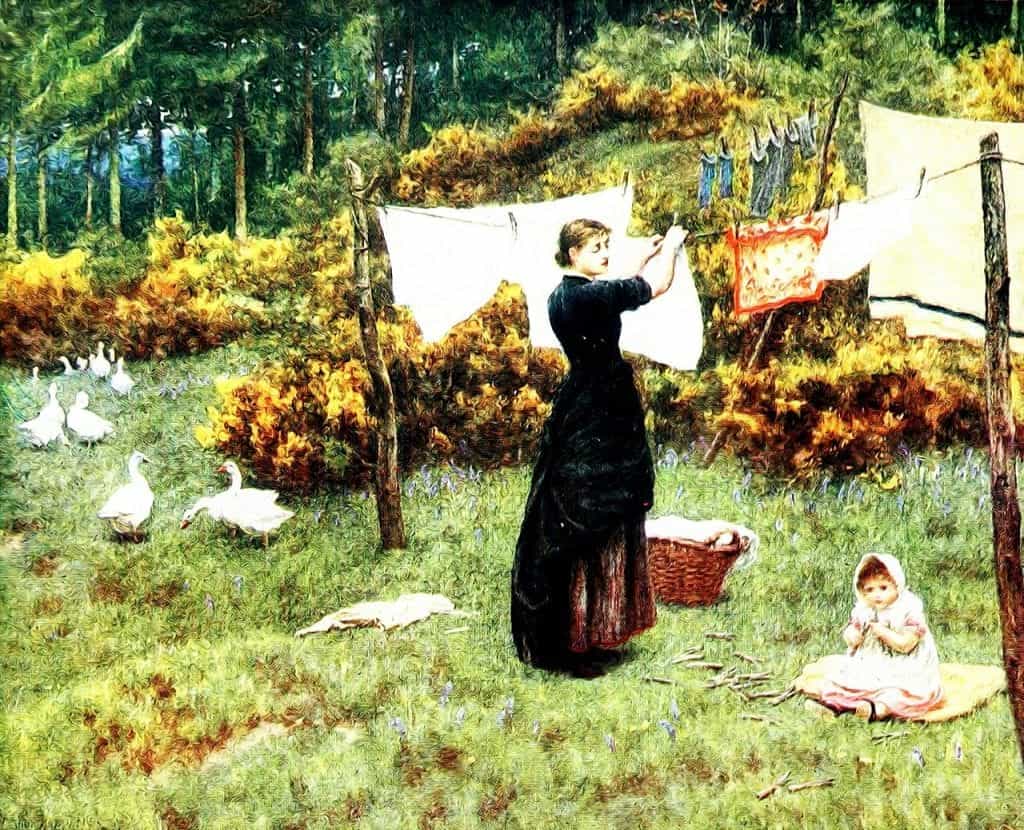
My Weekly Laundry Routine
Perhaps you’re wondering how this all looks when you put it together. Maybe my “non-extreme” strategies actually do seem a little extreme to you. Here’s what my laundry routine looks like within a week’s scope.
I wash laundry twice per week, washing 3 -4 loads per week in total. One to two loads of kids’ clothes, one load of adult clothes, and one load of towels and/or sheets.
On my washing days, I start one load using the methods above (quick wash, less detergent, etc). The load is done in 20 – 30 minutes. After that, I remove the laundry from the washer and start the second load using the same methods.
While that load is washing, I sort the wet, clean laundry, placing some of the clothes/towels in the dryer and hanging up what I can. I hang the clothes on a drying rack in our living room, next to the heat register. I also hung some clothing on hangers in the large doorway that divided our living room and schooling area. By the time I’m done, the other load in the washer is usually done. I follow the same method, dividing the clothes by what needs to go in the dryer and what can be hung up. After I’m finished, I can start the dryer, which is full of each half of the loads. Then I finish my hanging.
UPDATE: I now hang dry all of our clothes and don’t own a dryer. Here’s how that’s going.
This is my laundry routine for winter. The hanging clothes actually help add humidity to our home when everything is so dry. During the summer, I, of course, won’t have the heat running, and I don’t want the added humidity in my house, so all clothes get hung up on my laundry line, which I string back and forth in our sunroom/entryway.
It doesn’t sound so extreme when you put it all together in the scope of a routine, does it?
When our front loader died all we could afford was a 2nd hand top loader. I found little to no difference in our electric and water bills. This is probably due in part to base rates on both services. I have been making your laundry soap for over a year. While it doesn’t save me money compared to what I was using before, my clothes come out cleaner and I don’t get that stale smell with things in the linen closet or clothing in the drawer for more than a week. That makes taking the time once a month to make it. I also use dryer balls. I compared the same size load of towels. With the balls it was 10 min less. With a busy life, time saved on waiting for the dryer is more important. Electricity is a bonus.
Melissa, Little House Living reader

How Much Can You Save?
I know that was a LOT of info and tips, so I will sum it all up for you here.
Regular Load of Laundry
If you do a regular load of laundry, use hot water and expensive detergent, and run the entire load through the dryer, it will cost you around $1.73 per load, not including things like stain remover, dryer sheets, etc if you use them.
Frugal Load of Laundry
Using all of the tips here, a load of laundry will cost you about $0.16 to $0.60 per load, depending on whether or not you dry it.
Washing one load every day using regular methods, your laundry cost for the year will be around $631.45.
Washing one load every day using frugal methods and line drying, your laundry cost for the year will be around $58.40.
A savings of $573.05!
Isn’t that crazy? Each thing individually doesn’t add up too much…maybe even just a few pennies per load when you add up something like using a smaller amount of detergent. But when you put them all together and look at the cost savings overall, the figure is impressive. I definitely have plenty of other things I would rather spend my $573.05 per year instead of laundry!
Tip: Get 50 more tips for saving money here.
Plus, the washing machine and the dryer are just 2 appliances in our homes…if we were to work on more frugal strategies with all of the appliances, just how much might we be able to save?
You can also hang clothes on hangers along the door frames or use a rolling garment rack when you can hang outside. We pretty much hang dry anything that isn’t already fading from wear over time so that it will last longer and not fade.
CR, Little House Living reader

Which of these frugal laundry strategies do you use? Which one will you try and add to your routine next?

Merissa Alink
Merissa has been blogging about and living the simple and frugal life on Little House Living since 2009 and has internationally published 2 books on the topic. You can read about Merissa’s journey from penniless to freedom on the About Page. You can send her a message any time from the Contact Page.
These Frugal Laundry Strategies were originally published on Little House Living in January 2018. They have been updated as of December 2023.



Dear Merissa, I live in Germany where front loading washers are standard for at least 30 years. Top loaders are comparably hard to find in stores. After some research before buying our last washing machine I am very sure that using the quick washing cycle does not save you money, at least if you do not live somewhere where the water used is very cheap or for free. Those cycles use up a considerably higher amount of water whereas the longer cycle uses more movement to clean the clothes. Of course, I am no expert but I that is what I found out reading several different sources. I hope this information may be helpful for you. Best wishes! Nicole
I just re-read an article and would like to correct myself: quick cycles use more water and energy (more movement), longer or even eco cycles soak more and the movement is less compared to the short ones (therefore less energy and less fresh water used). By the way,I just found your blog recently and I like a lot what I habe read so far!
I would love to know how you only do 3-4 loads per week. I have 4 children in addition to me and my husband. I do 3-4 loads per day, 5 days (and sometimes 6) per week.
Since our kids are little and their clothing is little, I think that helps…I can fit a lot in one load!
I had the same question. Our kids are older and involved in sports. I easily do 2-4 loads/day.
I have 4 young adult sons. Back in the days when they were all at home my peak laundry years were when they were between the ages of 9-19. I did 15-20 loads a week including bedding and towels. I washed 3x per week usually 3-6 loads at a time depending on the season. I also had sports uniforms and work uniforms that needed to be washed separately because of them being so dirty. That added to the number of loads. I believe Melissa washes 3-4 loads 2x per week which is 6-8 loads. As she says her kids are still little so you can pack more in a washer. When my 4 were younger and even though I was washing cloth diapers for the youngest I was only doing 5-10 loads per week. A lot depends on where you live and the lifestyle that you lead. Melissa is in a rural area and homeschools her kids so I would think she may be able to stretch out the need to change clothes as frequently. I was able to cut down in the summer by doing this but when they were in school they usually needed clean clothes everyday. I live in a big city and my kids went to school and had to look presentable. With 4 active boys, that doesn’t last very long.
Awesome article! I think I may have used my dryer once last year, maybe. I have a drying rack in the house for the winter and a umbrella like rack that I can take down in the summer. Anyone who takes 25 min to hang out a load of laundry needs to put their cell phone down while doing it 😉 it only takes me about 5-10 min to hang out a load. To bring it in I can fold it as I put it in the basket, while enjoying the vitamin D from the sun. Since I can put the outdoor rack away, it’s easy to cut the grass and the look of my yard is not detracted. Also putting it in the garage when not in use has saved the lines from constant UV exposure. And I get a cute clothespin bag to boot. Drying indoors adds humidity that is lost in the winter which I monitor with meters in my house. I have a top load which I can “tamper” with the settings to save time and money.
I don’t know why this is so hard for people to consider. I make a game of saving money. I have driven the energy costs of my house down to less than a quarter of what the family before me used with very little effort. And in fact I have ordered a gadget that will show me just how much each appliance and electrical device is using (computers, power bars etc.) Have even considered solar panels for my garage to take it off the grid when plugging my car in for the winter. When we flip a switch we expect power to come on but really don’t think about where it comes from. Waste is waste in all forms. So thank you for reminding us that there is a better way of living.
Hi Theresa…..I’m 60 and my Grandmother who had 13 children always said to fold laundry as you took it off the line. This was during the time (think late 1890’s to early 1930’s, {my Mum was born in 1920}) when everything was made from cotton or linen. Said that it was half way ironed if it was folded well. I do the same thing, especially things that are folded and put away, like hubby’s t-shirts, work pants, undies and socks…all get properly done outside, and that way it just goes from the hamper onto the shelf in the closet.
I don’t do this anymore but did when my children were at home, I turned off the electric not says it heater before I went to bed and turned it on when I got up the next morning. The savings at that time, which was 20 years ago, was $8 a month. We always had enough for short showers when needed.
I might get around to trying your techniques someday. However, I have three community college students living here right now. Until things slow down, will not be able to do these techniques. I used to pay more attention to laundry. However, not lately.
I keep the whites, stained clothing items etc in separate stacked baskets. Once the basket is enough for the washer, it has a turn to either soak or gets washed.
Any washing I do, get shaken out well before hanging and placed on hanger where possible, that cuts down on ironing substantially. As I use a clothing rack there is no need for pegs – a time saver!
Each person in the family has a pack away basket, as clothing is dry it gets folded into their individual baskets,which cuts down a bit of time on the after sorting.Teenagers in general have a lot of washing so I let mine pack their own away – makes them aware of the amount of
clothing they use
I only wash laundry once a week, lol. Seriously. Sunday is my washing day. Unless someone had an accident or needs something quickly, I’m only doing laundry one day a week. It’s my husband, myself & 2 boys.
One of which who has asthma. I’ve wanted to hang my clothes outside to dry for years, but his Doctor told me to not do that. Hopefully once he’s older, I can start.
I’ve subscribed to your blog for awhile, I really enjoy it.
Have you tried hanging them out and then running them in the dryer for 5-10 minutes to remove pollens and any bugs?
How many loads/week does vary a lot by family. We are probably closer to 4 loads/week, but I have friends that do much more. I have been trying not to wash clothes until they are visibly dirty or smell, not after every wear. Clothing lasts SO much longer when washed in cold & line dried like Merissa suggests and not washing as often!
Thanks for the article:)
I hang dry almost everything. In the summer I have a line outside and if it’s sunny and a bit breezy I can get 3-4 loads out there a day. I usually do my laundry on the weekend. In the winter I have two drying racks that I put in front of the baseboard heaters, one in the bedroom and one in the living room. Lighter things get hung up on hangers and put in the closet or the shower curtain. The only thing I dry in the dryer in the winter is hubby’s heavy work hoodies…they take about 3 days to dry on the rack and by then they smell funky, and the towels. I even drape my sheets on the racks, folded into thirds and then after a few hours they get flipped over. I haven’t made my own laundry soap yet, but a year ago I made some home made soap and put too much oatmeal in it, so I’m thinking of grating it up and using it for laundry. Thanks so much Merissa…..Love your blog and all your suggestions for living a more sustainable life.
If I have heavy items that don’t dry fast, I add a fan to the rack to speed it up. As long as the appliance doesn’t have to generate heat, it is still lower cost than the dryer. I also have ditched the flannel sheets for the bed. They take up too much water and take forever to dry, both on the rack and in the dryer. I have found these polyester sheets that are 1200 thread count for $25 a set. With the new synthetics, they are warm as toast and actually breathe. I have also made my pajamas out of light weight fleece. Both the pajamas and sheets dry in no time and are wearing much more efficiently that the cottons I previously used. And with the fleece I can turn the thermostat down at night. It was a big leap to embrace synthetics but the argument to buy something to last longer and be less of an impact on the environment won. Synthetic fibers can be made from reclaimed products and the processing of natural fibers is not without it’s own impact. The amount of water needed to produce linen is shocking. I wish more people would embrace savings for savings sake and not do it only when their backs are against the wall. It’s not about being poor, it’s about having consciousness and awareness.
I think it is really important to be aware of how little savings can add up over a period of 12 months. Thank you for this article Merissa.
When our front loader died all we could afford was a 2nd hand top loader. I found little to no difference in our electric and water bills. This is probably due in part to base rates on both services. I have been making your laundry soap for over a year. While it doesn’t save me money compared to what I was using before, my clothes come out cleaner and I don’t get that stale smell with things in the linen closet or clothing in the drawer for more than a week. That makes taking the time once a month to make it. I also use dryer balls. I compared the same size load of towels. With the balls it was 10 min less. With a busy life, time saved on waiting for the dryer is more important. Electricity is a bonus.
You can also hang clothes on hangers along the door frames or use a rolling garment rack when you can hang outside. We pretty much hang dry anything that isn’t already fading from wear over time so that it will last longer and not fade.
I Wish i could hang laundry. While I appreciate the notion of how everyone can hang laundry, sadly that is not true. I have outdoor and indoor allergies. Most severely to dust mites. I can either wash in hot water to kill the dust mites in laundry or I can dry with medium or high heat in the dryer to kill the dust mites. I go with the cold water and still dry in the dryer. Thankfully it’s just me and my husband with oneload of laundry every 2 weeks.
What are magnet balls??
You can read about them here.
You say you have a modern washing machine ? why then don’t you set it to do the washing during the night ? instead of early in the morning, that will save you even more time before the kids get up. It’s also cheaper to do it then.
My washer/dryer shares a wall with one of the children’s bedrooms so I can’t do laundry at night or it would wake her up. We also are not on any energy savings plan here for using appliances at night so it wouldn’t save us money.
If you have solar panels it’s best to use all electric things during the day as your using the power from your own source. It makes it heaps cheaper too!
Thank you for the article Merissa. My only comment is that in doing my laundry, I’ve taken a cue from our ancestors to ensure clean loads with these short agitation cycles. I allow the machine fill and agitate with the clothes a few minutes, then I turn off the machine and set a timer for 30 minutes for a good soak. I then start the cycle over again and allow the load to finish. Our foremothers regularly soaked their laundry before washing it (by hand), and for particularly dirty loads would even let them soak overnight. It allows the soap and water to get deep down into the fibers, making it easier for the washing to carry away the dirt and grime.
I really enjoyed reading this post! I strive to be practical and frugal with what I do as a homemaker and every bit of savings counts in my books! I’m very motivated to put these excellent tips to use in my home. Something I’ve been doing lately which you mentioned is to handwash my kitchen towels in the sink and air dry. I do this every few days and have come to really enjoy the process.
Love your blog! Thank you from Saskatchewan Canada!
Add a few drop thieves essential oil to help kill germs.
Hi Merissa:
I think there are as many ways to do laundry as there are people on the planet. I raised 4 boys and they certainly generated a whole lot of laundry. When they were little I was able to get more in a load but as they grew into tall lanky teens with jeans that seemed to be 6 feet long my weekly wash was about 15-20 loads per week. Sports and work uniforms had to be done separately because of the amount of dirt or grease on them. Towels had to get changed out every day because after they had a shower the towels reeked of boy teen BO. Back in the day, I just waited for detergents to go on sale and sometimes I could add a coupon to that price. If possible I doubled my purchase. I used dryer balls most of the time. If I needed to use dryer sheets, I cut them in half or thirds and found no difference. I do hang some of my stuff on lines in the basement but do use the dryer a lot due to not being able to hang outside due to stupid city bylaws. But that being said, I do not have the yard space for a line anyhow. We save money on electricity by signing a contract with a utility company which bundles our gas (heating) and power on one bill and we get a deep discount for doing that.